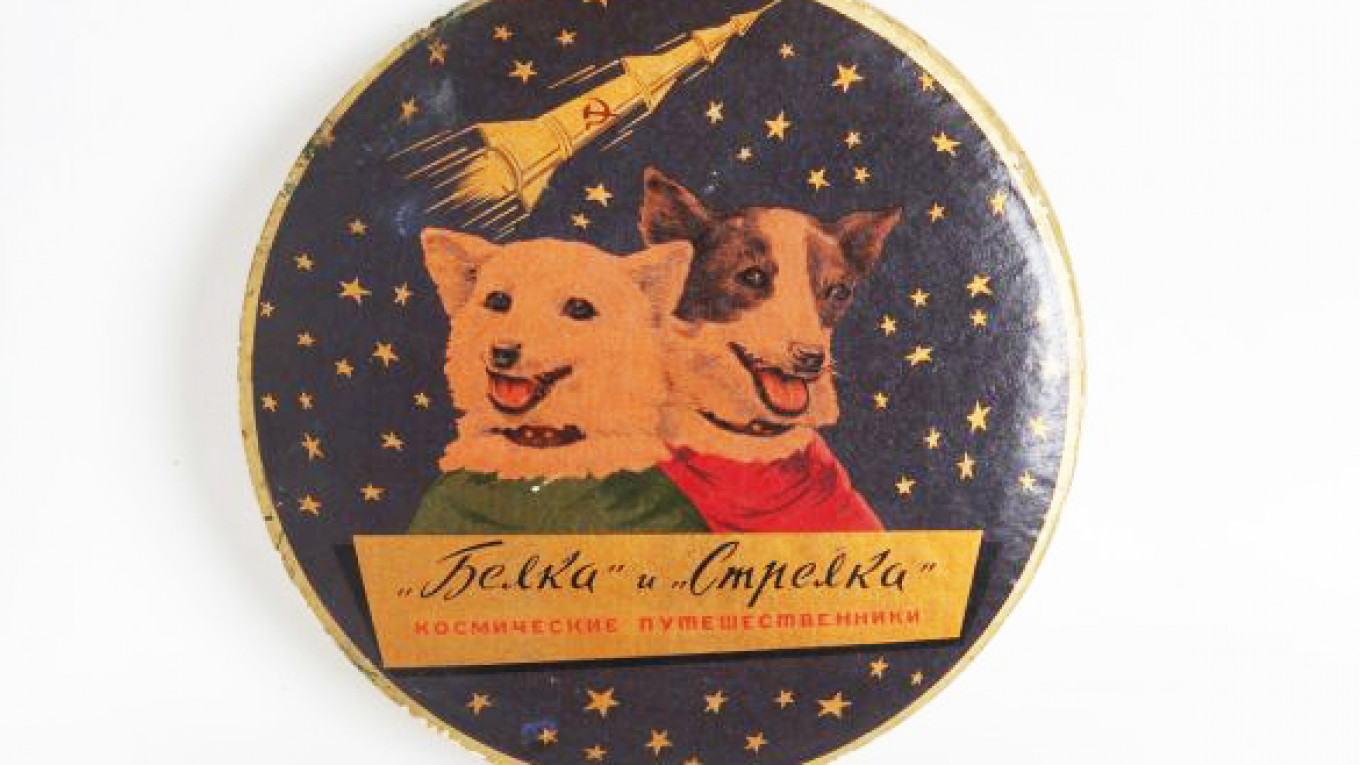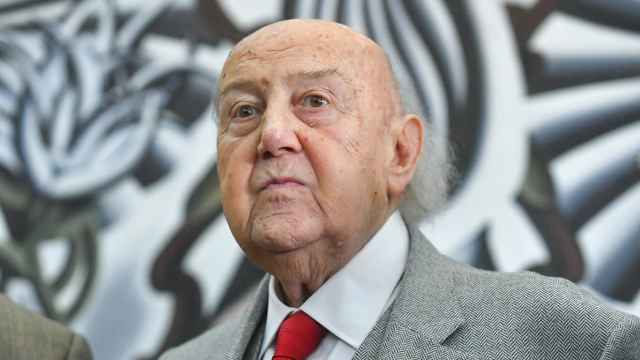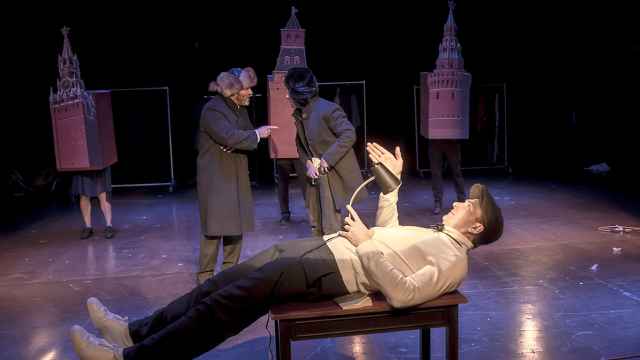"Packaging Design: Made in Russia" has been visited by some 110,000 people since it premiered at the Manege. Now stationed at The Rabochy i Kolhoznitsa Exhibition Hall — because of the sheer level of public interest — it has just over a week remaining until it's dismantled on August 18. This has not prevented its curator from expressing hope that one day her team can establish a more permanent collection.
Set out as a timeline, the display stretches from the early Middle Ages up until a selection from the present day, from which every Russian child would likely recognize something from their own home.
"We wanted to display the history of packaging, starting from our first 'packaging solutions,' through the industrial revolution, and the 1960s, up until contemporary design," said Alyona Sokolnikova, the exhibition's curator, who appears surprisingly young for somebody who spends the remainder of her time teaching at universities.
In the exhibit's prime position, as the centerpiece of the room, are some temporary donations from a completely anonymous source. The unopened, decades-old packages are estimated to be worth around half a million rubles each. "These are the most unique," said Sokolnikova. "The collector didn't want to reveal his name. He has never displayed them before." All are from the end of the 19th century and beginning of the 20th.
Starting at the beginning of the timeline, visitors can see replicas of the eighth and ninth century animal skin pieces from which the collection begins, moving on to the packages which "had the first labels … that show information while at the same time having a decorative function."
"Even before we officially changed our religion to Christianity, we had some early symbols which we put on packages. It was similar in different cultures," she said, going on to mention one of the most important packaging marks of a later era.
"You see, they have an eagle, which connects the product to the Tsar's family," she said, gesturing toward a tin of caviar. "Once you have this crest, you remove all the other medals, everything else. You could only get it for yourself and not lend it to your wife or your children, for example."
The early periods, it seemed, were characterized by packaging directed at people who were wealthy enough to afford the product inside: luxury products. An industrial revolution in Russia changed all that.
"We ended up with all this technology … [and] a new class of people who got money from industrial production but didn't yet have a culture of decorating," Sokolnikova explained. "When the people finally got money they tried to put together all the fashionable things they could find with no plan."
A variety of styles are discernible: Victorian sentimentality, neo-Russian, art nouveau, Russian avant-garde. "You can see our head of the army drawn as something resembling a closet gay," she laughed, picking up a battered early 20th century piece.
"At the same time you can find some similarities between the British arts and crafts movement and the Russian story because we also rediscovered our 15th and 16th century culture," she continued. "Later it morphed into neo-Russian style, which is really amazing, because later, by the 1910s, we developed a strong connection with art nouveau style. You can tell from the illustrations from Russian fairy tales that there was a combination of Japanese and French influences as well as traditional Russian."
Surprisingly, the revolution didn't have an immediate impact on the designs which were produced, and the reversion to the bold prints typical of Mayakovsky's booklets and comics did not become de rigueur until a little later.
"After they nationalized all the production, they still used the old design versions here because they had no time design something of their own," Sokolnikova explained.
However, the constructivists' goals quickly took over. The exhibit progresses on to the geometric packaging designs and advertisements of Alexander Rodchenko and Vladimir Mayakovsky — artists from such trusts as "Mosselprom" (the Moscow Rural Cooperative).
"It belonged to the new, young government — they needed a new strong communication to compete with the other sellers," said Sokolnikova. The creation of a strong visual identity was key. "They needed to communicate with people who only learned to read and write two or three years before, so they needed to be bold and short with their communications."
The building itself was stamped with the phrase "Nowhere else but Mosselprom," with kiosks bearing the same slogan being peppered around the capital.
The timeline then progresses to packaging with a propaganda function. "It does nothing but commemorate Russia's unity with the Ukraine," Sokolnikova said, picking up a package with minimal detail on its exterior. "You can't even tell what's inside," she pointed out.
The same post-revolutionary period saw some problems with typefaces develop and an increase in the use of hand-drawn cards. There's a noticeable decline in quality around the 1940s and 1950s. "Because of the low quality of printing in the 40s, the designers could not recognize their original work after it was finished," she said.
Condensed milk gets its own special section, with the packaging being one of the most distinguishable in Russia, its notoriety being on a par with that of Campbell's Tomato Soup in North America. Similar pop-art designs have even been produced by Studio Art Lebedev. Variations in the packaging were notable in both the 1930s and 1960s, but according to Sokolnikova, "this is still the most recognizable and produced, without any serious changes … and it has an additional function — you can boil it."
One other notable product is the casing for "Stone Flower" — the perfume presented by Nikita Khrushchev to First Lady Jacqueline Kennedy during the Vienna Conference in June 1961.
Mass-produced objects such as tea tins are not considered rare but are documented nonetheless. It is still possible to pick up many of the later designs in flea markets. One very sweet wooden penguin salt-shaker is available on Etsy, and the cameras are described by Sokolnikova as "something like those that contemporary hipsters would buy."
Despite the popularity, the overwhelming motivation behind setting it up was sheer interest and passion for the subject.
"We're not doing it for money — we're just doing what we believe and we're happy," she said. "We hope one day to attract sponsors and maybe we could set up our own building documenting the history of design and packaging design throughout Russia, and its evolution to the contemporary period … but it's a really long term dream," she said.
"Packaging Design: Made in Russia," is showing until August 18 at "Rabochy i Kolhoznitsa" Exhibition Hall, 123B Prospect Mira, Metro VDNKh.
A Message from The Moscow Times:
Dear readers,
We are facing unprecedented challenges. Russia's Prosecutor General's Office has designated The Moscow Times as an "undesirable" organization, criminalizing our work and putting our staff at risk of prosecution. This follows our earlier unjust labeling as a "foreign agent."
These actions are direct attempts to silence independent journalism in Russia. The authorities claim our work "discredits the decisions of the Russian leadership." We see things differently: we strive to provide accurate, unbiased reporting on Russia.
We, the journalists of The Moscow Times, refuse to be silenced. But to continue our work, we need your help.
Your support, no matter how small, makes a world of difference. If you can, please support us monthly starting from just $2. It's quick to set up, and every contribution makes a significant impact.
By supporting The Moscow Times, you're defending open, independent journalism in the face of repression. Thank you for standing with us.
Remind me later.






